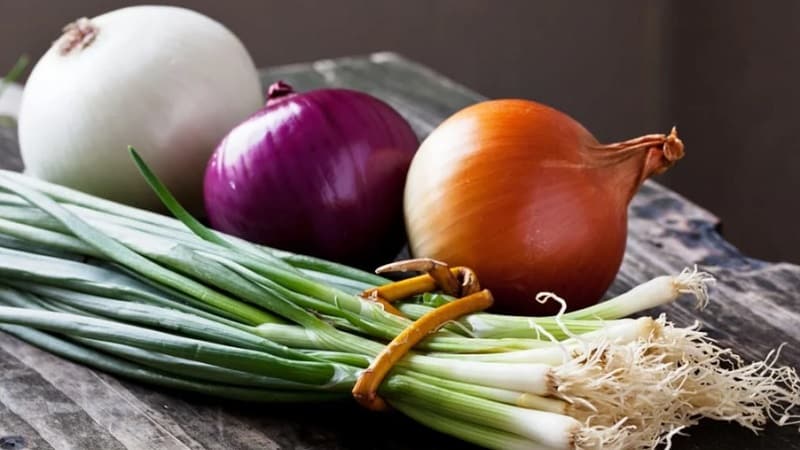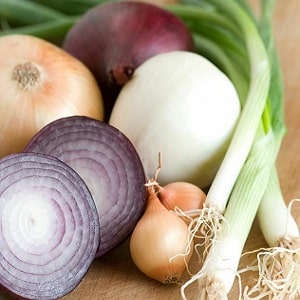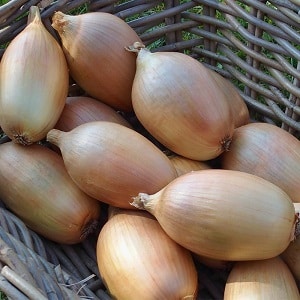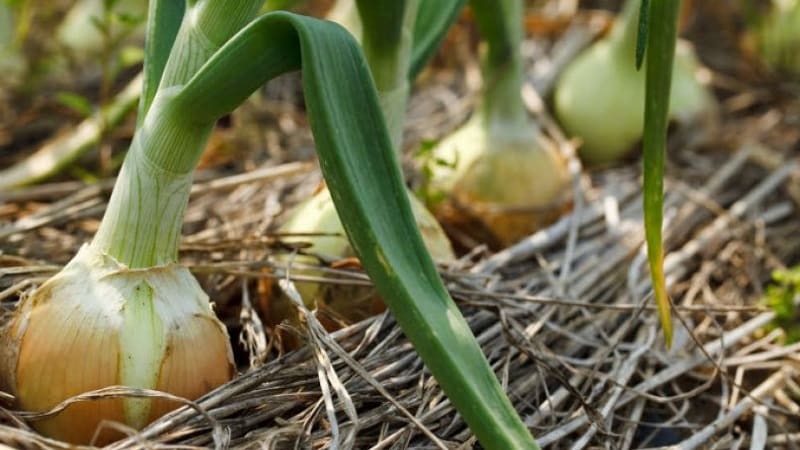What types of onions are there, their characteristics, and which variety is best suited for long-term storage
Onions are a common vegetable crop for growing on farms and in gardens. Productivity depends on the selection of suitable species and varieties, planting season, climatic conditions and compliance with agricultural technology standards. We'll talk about this and much more further.
What is an onion
Onion is a genus of biennial and perennial plants of the Amaryllis family.. All species are herbaceous and have a sharp, specific odor. Both the stems and the bulbs themselves are used in cooking.
Among the species there are also those that grown for greens:
- skoroda (chives);
- leek;
- slime (drooping bow);
- batun;
- Shallot

Varieties and hybrids suitable for long-term storage are valued for their keeping quality, medium and large size of bulbs, their taste. Consumers like vegetables that are “sweet” and don’t cause tears when peeling and chopping:
- Red Baron;
- Globo;
- Comet F1;
- Exhibition.
Origin and development
People began cultivating onions 4-5 thousand years BC on the territory of Asian countries: modern Afghanistan and Iran. The first cultivated plant was onion.
The vegetable was consumed in ancient India, Greece and Egypt. There, the plant was also credited with magical significance: it was believed that it gave strength and courage.
In Western Europe, the vegetable appeared in the 5th-6th centuries AD. e. In Russia later - in the XII-XIII centuries.
Due to the cold resistance of the crop, it is grown both in subtropical climates and in northern latitudes. Onions grow and develop at temperatures of +3…+5°C.
Chemical composition
Onions contain a lot of substances that are beneficial for humans.. Sugars are represented by glucose, sucrose, fructose and maltose. The vegetable contains 10-11% of them. This means that in terms of the amount of sugars, the spicy vegetable is not inferior to the sweet pear.

Plant contains citric and malic acids, polysaccharide inulin, fats, phytoncides, an essential oil with a disulfide, which provides the characteristic pungent odor.
Vitamins in vegetables:
- thiamine (B1);
- riboflavin (B2);
- pantothenic acid (B5);
- pyridoxine (B6);
- folic acid (B9);
- ascorbic acid (C);
- tocopherol (E);
- biotin (H);
- niacin (PP).
Microelements:
 iron;
iron;- rubidium;
- aluminum;
- copper;
- iodine;
- zinc;
- chromium;
- boron;
- fluorine;
- manganese;
- cobalt.
Macronutrients:
- calcium;
- potassium;
- sodium;
- magnesium;
- sulfur;
- phosphorus;
- chlorine.
The vegetable activates hematopoietic processes, normalizes water-salt metabolism in the body, lowers blood sugar levels.
Varieties
What types and varieties of onions are there? They differ in shape, color, taste, ripening time and shelf life. The genus Onion includes more than 900 species of plants, including ornamental, edible and wild ones.
Bulb
Onions are a perennial plant with a fleshy, round or slightly flattened bulb. (turnip). Depending on the variety, the colors of dry scales and pulp differ (there are white, yellow, purple shades).
The crop produces marketable turnips in the second year after sowing nigella. In the first year, small sets grow, which are planted to produce large, selected onions.
In the northern regions of Russia, the duration of growing vegetables lasts up to three years: due to the harsh climate, the crop does not have time to ripen to a marketable state in two years.
Popular varieties of onions (with description):
 Timiryazevsky - was developed back in 1968, suitable for cold regions. Early ripening (ripens in 77–82 days). Productivity is average, 2–3.2 kg/m2. The average weight of a vegetable is 50–70 g. The taste is pungent.
Timiryazevsky - was developed back in 1968, suitable for cold regions. Early ripening (ripens in 77–82 days). Productivity is average, 2–3.2 kg/m2. The average weight of a vegetable is 50–70 g. The taste is pungent.- Myachkovsky (photo on the right) - early ripening, produces flat, semi-sharp bulbs weighing up to 70 g. Suitable for storage. Marketable yield is 197–315 c/ha. Recommended for the North-Western, Central, Volga-Vyatka, Middle and Lower Volga, Ural regions.
- Karatalsky - early ripening, suitable for the Central Black Earth, North Caucasus and Lower Volga regions. The weight of the vegetable is 50–120 g. The taste of the pulp is semi-sharp. The variety has good keeping quality.
Green
Young tubular shoots of onions and other types of onions are called green.. There are varieties with small turnips that are grown for their greenery, which is used almost all spring, summer and early autumn.
Slime
Drooping perennial onion, appears in early spring, grows to lush bushes. It has wide, long stems similar to iris stems.
By the way. The plant is very fragrant, it is used in salads and for decorating dishes.
Propagated by seedlings, division and seeds.
Varieties:
 Green (pictured) - Siberian selection, is not afraid of cold weather, does not suffer from white rot, downy mildew, penicillosis, or rust. It grows in one place for up to six years. The taste is mildly pungent, the leaves are tender, juicy, yielding 4–6 kg/m2 per cut.2.
Green (pictured) - Siberian selection, is not afraid of cold weather, does not suffer from white rot, downy mildew, penicillosis, or rust. It grows in one place for up to six years. The taste is mildly pungent, the leaves are tender, juicy, yielding 4–6 kg/m2 per cut.2.- Waltz - suitable for cultivation throughout Russia, frost-resistant. Early ripening: delicate spiral-shaped leaves are harvested after 28–30 days.The taste is mildly spicy and delicate. After 2 years they get 4.2 kg/m2.
- Charm — suitable for all regions, resistant to cold weather. Mid-season: leaves reach technical maturity in 37–40 days. The taste of greens is slightly spicy. 100 g of leaves contain 64.25 mg of vitamin C. One cut yields 1.7 kg/m2, for several - up to 4 kg/m2 with long-term cultivation.
shallot
Popularly known as “kuschevka”. Perennial, leaves ripen within 30 days. It stores well, is unpretentious, and with proper care produces a rich harvest. Forms up to 12 bulbs.
shallot has a delicate taste. Like onion, it can be sweet, spicy and semi-sharp. It is also called the aristocratic onion, since previously the species was available only to wealthy people. The plant quickly sprouts, develops, and delights with tasty shoots from early spring.
Varieties:
 Albik (pictured) - mid-season, suitable for winter planting. The bulbs are round, there are up to 11 of them in a nest. The taste is semi-sharp. Turnip yield - 1.7 kg/m2. Suitable for all regions.
Albik (pictured) - mid-season, suitable for winter planting. The bulbs are round, there are up to 11 of them in a nest. The taste is semi-sharp. Turnip yield - 1.7 kg/m2. Suitable for all regions.- Belozerets-94 - early (76–85 days pass before the leaves turn yellow). Productivity - 1.2–1.4 kg/m2. Juicy scales are purple, the taste is sharp. Zoned for the North Caucasus region.
- Guarantee - mid-season, suitable for all regions. The harvested crop is stored for six months. The taste of the white pulp is semi-sharp. Turnips receive up to 1.7 kg/m2.
Batun
The trumpet forms almost no bulbs; all the strength of the plant goes into stems up to 1 m high. Appears early and is not afraid of frost. If the seedlings are covered with film immediately after the snow melts, the first cut of the stems is carried out already in April.
Feathers are eaten fresh, salted or frozen. During processing it does not lose its beneficial qualities.
Interesting. This form contains 2 times more vitamin C than onion feathers.
Varieties:
 April (photo on the right) - early: 102–142 days pass from full germination to the death of the feather. Resistant to diseases and pests, suitable for all regions. The leaves are tender, juicy, and semi-sharp in taste. Productivity - 100–181 c/ha.
April (photo on the right) - early: 102–142 days pass from full germination to the death of the feather. Resistant to diseases and pests, suitable for all regions. The leaves are tender, juicy, and semi-sharp in taste. Productivity - 100–181 c/ha.- Baron - winter-hardy mid-season variety: leaves reach technical maturity in 35 days. The taste is mildly spicy. Marketable yield in the second year of cultivation - 9.3 kg/m2.
- Baia Verde - mid-season, disease resistant. Leaves are semi-sharp, yield - 4.2 kg/m2. Grown throughout Russia.
Leek
Leeks, or pearl onions, are also called “royal”. The plant can withstand frosts down to -7°C. It tastes tender, sweetish, with a slight hint of garlic.
Young greens and white stem are used for food.. The plant is suitable for canning.
Reference. Unlike other vegetables, when storing leeks, the amount of vitamin C in the white part increases by more than 1.5 times.
Varieties:
 Columbus - Dutch early ripening variety with a pleasant mild taste. Greens are used fresh, added to various dishes, and canned. Productivity - 3.1 kg/m2. Columbus is not picky about climate.
Columbus - Dutch early ripening variety with a pleasant mild taste. Greens are used fresh, added to various dishes, and canned. Productivity - 3.1 kg/m2. Columbus is not picky about climate.- Vesta (pictured) - a variety of domestic selection. Plant height - 100–140 cm, length of the white part - up to 50 cm. Productivity - 5.7 kg/m2. The taste is excellent.
- Elephant's trunk - mid-season, suitable for long-term storage. The taste of greens is sweet and tart. Weight - 150 g, yield - 4.3 kg/m2.
Elongated shape
Long onions are grown for turnips and greens. Many summer residents specifically choose this form of vegetables, because flat and round turnips are inconvenient to cut.
These turnips produce onions and shallots.
Popular varieties:
- Bamberger - a mid-early Dutch variety, high-yielding, sweet in taste, but with a pungent odor.It is stored for a long time, does not sprout and does not spoil. Easy to care for, resistant to pests and diseases. The bulbs are small, 60–80 g.
 Oval (photo on the right) - medium-late: 130 days pass before the feather lodging. Full-fledged turnips are formed in 1 season. Weight of vegetables - 150–200 g. The taste is semi-sharp.
Oval (photo on the right) - medium-late: 130 days pass before the feather lodging. Full-fledged turnips are formed in 1 season. Weight of vegetables - 150–200 g. The taste is semi-sharp.- Sturon - mid-late onion, disease-resistant. Suitable for storage. The weight of vegetables is 80–100 g, the taste and smell are pungent. Productivity is high, 230–350 c/ha. Recommended for the Central and West Siberian regions.
- Shaman - mid-season variety, unpretentious in care. Turnips are obtained from seeds after a year, from sets - after 2. The weight of vegetables is 50–90 g, the taste is semi-sharp. Productivity - 130–280 c/ha.
Sevok
Sets are small bulbs obtained from seeds.. They are used as planting material for growing large and medium-sized commercial turnips.
Small sets do not weigh more than 50 g, medium - 100 g, large ones weigh more than 100 g.
Popular varieties:
 Hercules (see photo) - an early ripening variety of Dutch selection, ripens in 75–80 days. Suitable for storage. The taste of vegetables is sharp. Marketable yield in the second year is 230–500 c/ha. Recommended for the Central region, resistant to drought.
Hercules (see photo) - an early ripening variety of Dutch selection, ripens in 75–80 days. Suitable for storage. The taste of vegetables is sharp. Marketable yield in the second year is 230–500 c/ha. Recommended for the Central region, resistant to drought.- globe - mid-season, grown from sets in a two-year culture. The weight of vegetables is 70–90 g, the taste is semi-sharp. Suitable for storage, resistant to fungal diseases. Marketable yield is 170–420 c/ha.
- Alvina - mid-season variety. The bulbs are flat, reddish, with a purple tint. The taste is medium hot. Maturation - up to 100%, shelf life - 6-7 months.
Which variety is healthier for the body?
The benefits of onions for humans are enormous., but it cannot be said that red is healthier than white, or vice versa.It all depends on the health problems or prevention goals.
Any variety of culture has a powerful antimicrobial effect due to the presence of phytoncides. Vegetables of purple and red colors are more active in the fight against pathogenic microflora, since, in addition to phytoncides, they contain cyanidin.
If a person’s task is to stop the harmful activity of microorganisms, then white onions will be enough, but if you also need to strengthen the circulatory system, then a red or purple vegetable will help.
The plant has anthelmintic properties. White turnips are more effective in combating freckles and pigmentation.
To strengthen the immune system and replenish vitamins Green onion varieties are suitable after winter.
Planting and growing different types of onions
There is no fundamental difference in the cultivation of different plant species. The main thing is to comply crop rotation rules: predecessors in the garden should not be related crops (other varieties or bulbous ones). Otherwise, the vegetables will begin to rot, and various diseases will “cling” to the plant.

When planting onions, monitor the timing and composition of the soil.: too early sowing, high soil acidity, deficiency or excess of nitrogen will not allow the plant to develop normally.
The place for the crop is chosen to be sunny and warm - the juiciness of vegetables and herbs depends on this.
Important! Loose, nutritious soil will protect the plant from rot.
The bed is prepared in advance. It is desirable that the predecessors be tomatoes or legumes. Onions grow well after celandine. Experienced gardeners even deliberately scatter it dried on the ground. The plant disinfects the soil, prevents the spread of diseases and pests.
The acidity of the soil should be neutral.The bed is fertilized with organic matter or mineral compounds.
How and when to plant
Onions are planted in early spring (on turnips) and in autumn (on the pen).
Planting sets:
- Warm up the bulbs if they were stored in a cool place, otherwise you will have to wait a long time for the green arrows.
- Sort through the planting material.
- Loosen the bed again and remove the weeds.
- Plant the seedlings to a depth of about 4 cm. The distance between them is 6–10 cm, between the beds – 20–25 cm.
Planting by seeds:
- Diagram - 13x1.5 cm.
- Depth - about 2 cm.
- After sowing, water the beds thoroughly.
- Cover the top with plastic wrap to create a greenhouse effect.
Cultivation and care technology
To protect plants from rotting and diseases, regularly remove weeds and loosen the soil. On average 1-2 times a week.

For juiciness of turnips and green stems the crop is watered once a week. In hot summers - 2-3 times. During prolonged rains, irrigation is temporarily stopped. Some onion varieties are drought-resistant and do not require additional moisture.
So that the onions quickly go green, it is fed with 1 tbsp. mullein, 15 g of urea, diluted in one bucket of water.
Reference. To remove the fungus, the culture is treated with a solution of copper sulfate. This is done when the stem reaches 15 cm. Some gardeners add crushed laundry soap to the solution.
Which varieties to choose depending on the time and region of planting
Despite the unpretentiousness and frost resistance of the plant, it is advisable to choose those varieties and hybrids that are suitable for a particular region. See the table for more details.
| Region | Varieties and hybrids |
| Northern |
|
| Northwestern |
|
| Central |
|
| Volgo-Vyatsky |
|
| Central Black Earth |
|
| North Caucasian |
|
| Middle Volga |
|
| Nizhnevolzhsky |
|
| Ural |
|
| West Siberian |
|
| East Siberian |
|
| Far Eastern |
|
It is better to plant varieties before winter Arzamassky, Danilovsky 301, Stuttgarter Riesen, Strigunovsky, Zolotnichok, Chalcedony.
For spring sowing in the middle zone fit Sturon, Centurion and Hercules.

Varieties for long-term storage
Onions with golden-colored dry scales have the best shelf life. Such vegetables have a more bitter taste and a pungent odor, but they are stored almost until the new harvest due to the thickness and number of outer scales. Sweet varieties have few scales, they are too thin, so the keeping quality of the crop is low.
Important! According to reviews from summer residents, sweet colored varieties of onions (red, purple) quickly lose their presentation and taste.
How to store it correctly
Fully ripe dry specimens are selected for storage., if necessary, dry them several times.
The wintering room should be dry and cool (temperature - 0°C). Some species thrive at -3°C, and some at +18°C.It is not recommended to display baskets with harvest on the balcony: the vegetable cannot withstand temperature changes.
Keep the harvest in winter in a “breathable” container: boxes, baskets, mesh bags. Some housewives, following traditions, knit bulbs into wreaths and braid them.
Conclusion
When growing this crop, pay attention to the description of the specific onion variety, its keeping quality, presentation and taste, and the regions for which it is recommended. Although this plant is easy to care for and resistant to adverse weather conditions, it is important to follow standard agrotechnical norms to obtain a rich harvest.